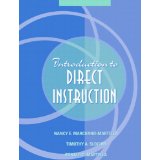Reading — From dream to reality
I am the mother of a nonverbal boy with severe autism.
It was very important to me that my son be able to read:
- I can accept that he has severe autism
- I can accept that he is nonverbal
- I could not accept that he would go through life not knowing how to read
It took me a long time and many hours of work. I made many mistakes. Eventually I succeeded. Here are the steps I used to teach my son to read:
- Make sure foundation skills are in place
- Use Direct Instruction reading programs
- Provide lots of supports and lots of opportunities to practice
- Use TAGteach to deliver precise, in-the-moment positive reinforcement for correct responses.
Step One: make sure foundation skills are in place
The skills a child with autism will need to begin reading instruction include the ability to sit at a table for at least 15-20 minutes and the ability to respond to questions or complete tasks (this is generally achieved through an ABA (Applied Behavior Analysis) or VB (Verbal Behavior) program).
During the pre-reading instruction, I focused on increasing the range of sounds my son could produce, and mastering as many labels of objects and actions as possible: such as cat, dog, house, running, sitting, sleeping and so forth.
A comment on increasing the range of sounds: I used Dr. Martin Kozloff’s excellent book, Educating Children with Learning and Behavior Problems, which has exact descriptions of how to have a child place his tongue and shape his mouth to make sounds. Since my son was nonverbal, I also used sign language to “sign” the sounds. This approach is similar to what is done in Verbal Behavior Therapy (VB); non-verbal learners are taught to respond with sign language. I have since learned that there is an effective pre-program called Visual Phonics. I am not familiar with it, but interested persons may wish to look into it.
 Step Two: Use Direct Instruction reading programs
Step Two: Use Direct Instruction reading programs
Many people are unfamiliar with the fact that there are scientific, research-validated methods for teaching academic skills. The most powerful and effective of these is a body of instructional programs known as “Direct Instruction.” These programs are based on both scientific principles of human learning and scientific principles of how to best teach specific academic skills. Direct Instruction (DI) curricula in reading, arithmetic, writing, spelling and language have a 40+ year record of delivering superior learning outcomes in all types of learners.
The specific program that I started with is a book by the founder of Direct Instruction, Dr. Siegfried Engelmann, entitled Teach Your Child to Read in 100 Easy Lessons. This book is widely available at bookstores and on the internet and costs about $25. By the time we were on Lesson 17, my son was reading. We eventually moved on to the well-known Direct Instruction Reading Mastery series.
Keep in mind, however, that DI program are designed for typically developing children who have speech. When you are working with a child with special needs, you have to approach things differently. It is very important to know your learner well and adapt the presentation so that your learner has success. Please note, I never made changes to the DI presentation itself. Primarily I provided extra supports, extra modeling, more repetition, or extra practice on certain parts of each lesson. Extra supports should be determined by the child’s level of performance.
Step Three: Provide supports, lots of opportunities to practice, and lots of high-value reinforcement
It is also very important to build a trusting relationship between the learner and the instructor. The child must have experience and confidence that he will only be asked to do tasks that he is capable of doing, and that he will only be asked to do tasks for the length of time he is comfortable performing them. The learner must be confident that the instructor will monitor the child’s emotional reactions and provide supports and respite as soon as he needs them.
Also, the child needs high levels of reinforcement throughout the instructional sessions. Basically, the child needs to know that he will experience only success and reinforcement throughout the process; he should never experience failure, fatigue or frustration. It takes time and practice for the instructor and the learner to know how much they can do and when to stop.
Step Four: Use TAGteach to reinforce correct responses
TAGteach is an outstanding way to reinforce a learner’s correct responses during reading lessons. For example, in the lesson the parent/instructor points to the letter M and says, “This sound is mmm, what sound?” As soon as your child says (or signs) mmm, tag and reinforce! In this case, the tag point is “Say mmm.” The tag is particularly good for helping a learner with reading because it reinforces the child for focusing on the sounds in the lesson (like the mmm above) and avoids the risk of distracting the child with unnecessary words and language.
Using TAGteach with a Direct Instruction program is an excellent example of how TAGteach supplements and complements other scientific instructional practices. Direct Instruction is a powerful learning tool. TAGteach is a powerful learning tool. Combine them, and you have an amazingly precise and effective learning program.
Where Are We Now?
I started teaching my nonverbal son with severe autism to read when he was 7. Now, at age 17 he can read third grade text at a fluency rate of 110 words per minute with no more than 0-2 errors. He easily decodes words like “impression,” “binoculars,” “stationed” and “boasted.” He is an excellent speller. He is completely comfortable with text and can work with charts, tables, diagrams and maps. Direct Instruction reading passages provide both fictional stories and academic content knowledge. As a result, he has learned a great deal about natural science, botany and animal behavior. When we go out to parks he studies the signs and information panels along the hiking trails.
What about reading comprehension? Well, it is difficult to assess comprehension when the learner does not have the speech capacity to produce the answer to a question, however, my son can answer both oral and written comprehension questions, with lots of practice. In written comprehension questions he has made a lot of progress, especially when I see his eyes flash back and forth from the worksheet to the book to find the answer to a question. He does it with cool competence and joy. He works very hard at his reading, and his determination is touching to see.
Does he love reading? Yes. Is he proud of himself? Yes. Was it worth it? Yes. Letters, words, sentences and paragraphs are now part of my son’s world. Reading is natural for him. He will go through life with the ability to read. What was the most important thing? Direct Instruction.
Resources
For more information about Direct Instruction, see below.
National Institute for Direct Instruction (NIFDI)
Please feel free to contact me through my website below if you have any questions.
What is TAGteach?
TAGteach stands for Teaching with Acoustical Guidance. TAGteach is a teaching and communication method based on the scientific principles of Applied Behavior Analysis (ABA).
TAGteach enables extremely precise positive reinforcement of behavior by using an acoustical signal to “mark” the behavior – at the precise moment the child performs the behavior! The acoustical signal is a short, sharp sound made by a handheld device (the “tagger”). When the child performs the correct action, the parent/instructor immediately presses the button on the tagger and hands over a treat (candy, treat, token, praise, social recognition, or money) as a reinforcer.
With TAGteach, it is easy to reinforce behaviors precisely and quickly. The immediate, accurate feedback and positive reinforcement result in the child performing the correct action more often, and for longer periods of time. With immediate feedback and learning tasks broken down into small steps, children (and adults) can learn many new skills with TAGteach — at their own pace.
 For more information visit the TAGteach website.
For more information visit the TAGteach website.
Join the free TAGteach Yahoo Group.
TAGteach taggers are available here.
See Martha’s book about TAGteach for Autism or feel free to ask me a question (with no obligation).
Sign up for my mailing list to receive updates, new articles and free tips right in your inbox!
If you liked this post, please share it. Thank you!





Comments are closed.